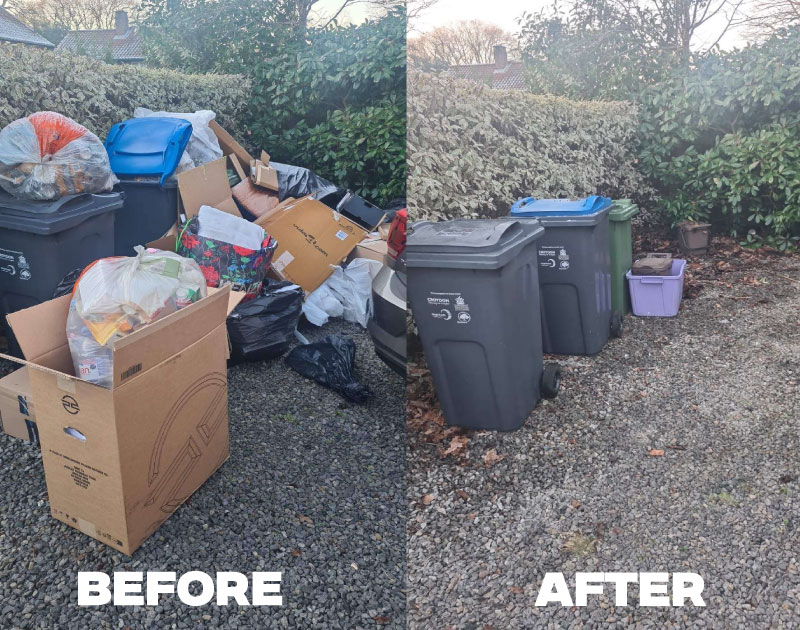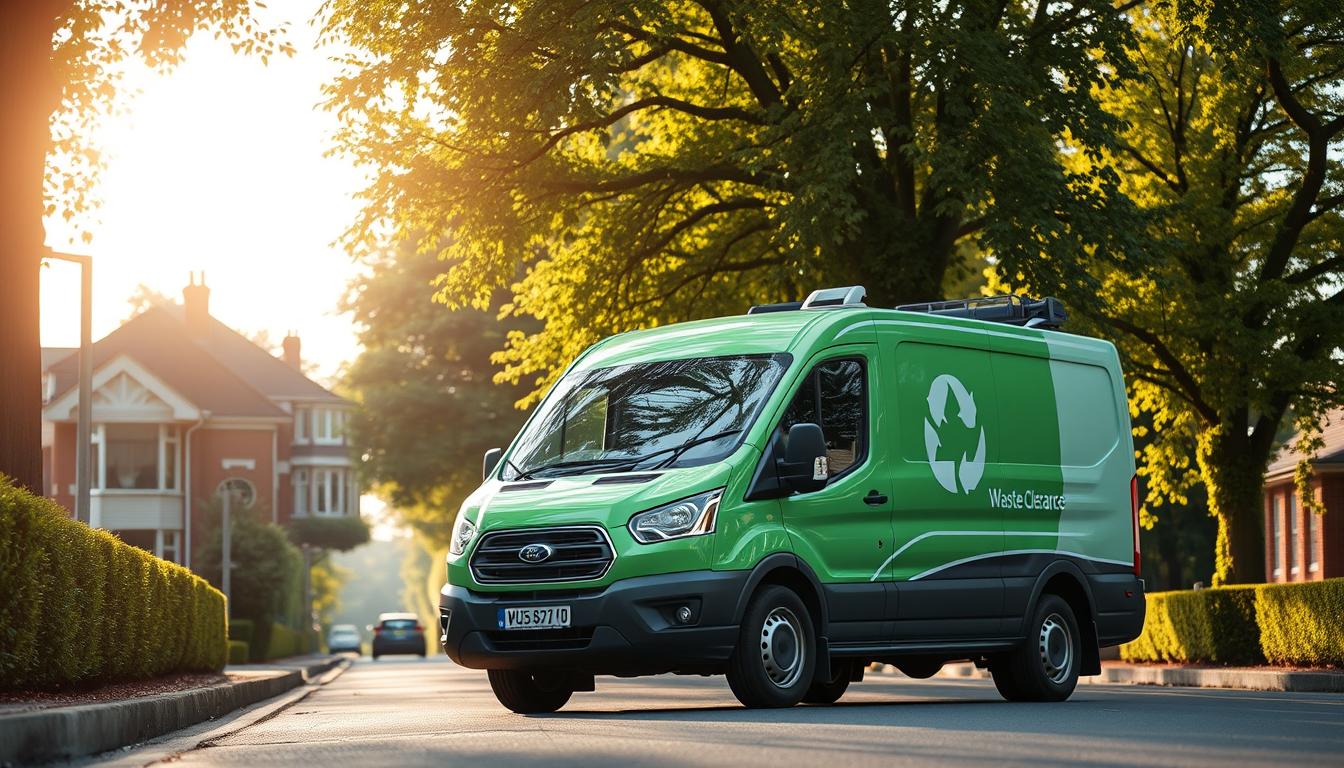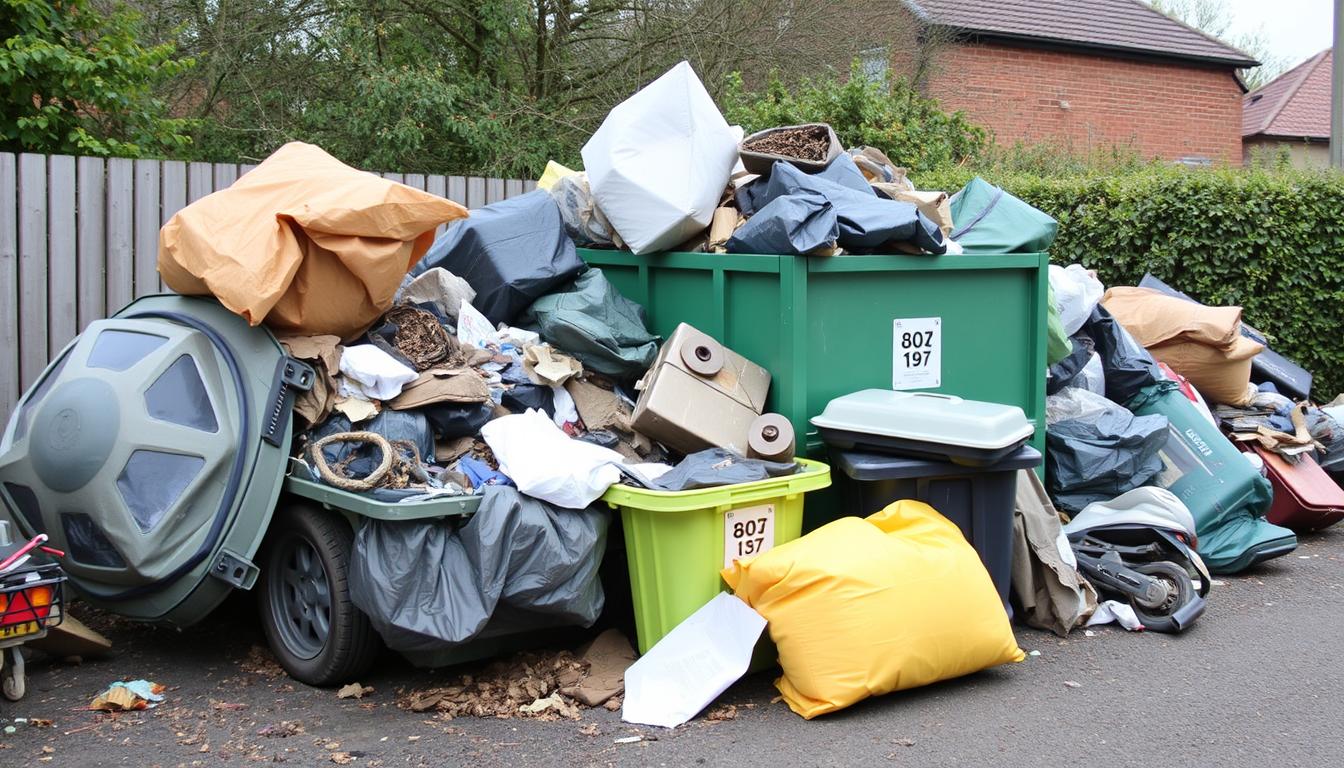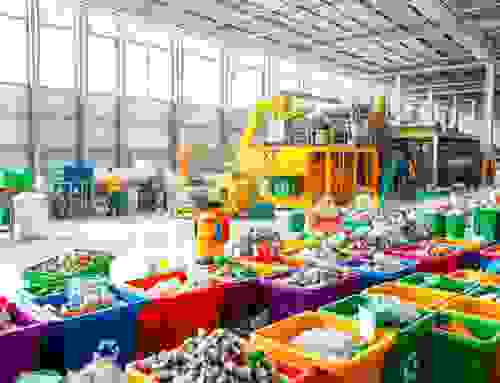The waste management industry in the UK is changing a lot in 2025. This change is because more people want eco-friendly ways to get rid of rubbish.
Old ways of getting rid of rubbish are being replaced by new, green methods. These new methods focus on recycling and using things again, not just throwing them away. Now, waste collection services offer detailed solutions for homes and businesses, all with the aim of being kind to the planet.
This move towards greener waste practices is because of what people want and stricter rules in the UK.

Key Takeaways
- The UK’s waste management industry is evolving to prioritise sustainability.
- Eco-friendly rubbish removal methods are becoming increasingly popular.
- Modern collection services focus on recycling and reuse.
- Sustainable clearance practices are driven by consumer demand and regulations.
- Comprehensive solutions are available for residential and commercial clients.
The Evolution of Waste Management in the UK
The way the UK manages waste has changed a lot over time. This change is due to worries about the environment, new laws, and new technology.
From Traditional Disposal to Sustainable Solutions
Before, the UK mostly used landfills to get rid of waste. This was bad for the environment, causing pollution and harming water. The old way was often just to hire a “Man and Van” to take the rubbish away.
Now, thanks to the waste hierarchy, which puts reducing, reusing, and recycling first, waste companies are changing. They now aim to reduce waste and find new uses for things.
| Traditional Waste Disposal | Modern Sustainable Practices |
| Heavy reliance on landfill sites | Emphasis on recycling and recovery |
| Simple collection and disposal methods | Sophisticated recycling and recovery systems |
| Significant environmental problems | Reduced environmental impact |
Why Sustainability Matters in Waste Clearance
Being green in waste clearance is important because it helps protect the environment and saves resources. Laws, like landfill taxes and recycling goals, have pushed the industry towards being more eco-friendly.
The idea of the circular economy is key in waste management now. It means keeping materials in use for as long as possible. Also, more people are aware of waste issues, which means they want solutions that are good for the planet.
Understanding Modern Waste Clearance Services

Waste clearance services have become much better, meeting the needs of both homes and businesses. Today, companies offer a wide range of services to deal with different types of waste in a green way.
Types of Waste Handled by Professional Services
Professional waste clearance services handle many types of waste. This includes general mixed waste, furniture, mattresses, and appliances. They also deal with construction and green waste, garden refuse, and fly-tipped rubbish.
They sort waste into different streams to increase recycling. This means they have special processes for things like furniture, electronics, and garden waste.
Trained teams identify recyclable materials on-site. This ensures proper sorting starts at the collection point. It makes the waste management process more efficient.
The Difference Between Traditional and Sustainable Clearance
Traditional waste clearance just sends waste to landfill. But, sustainable providers use special facilities to get the most value from materials. They use technology to track waste from collection to final processing.
Sustainable services also offer waste audits to help customers reduce waste. They handle difficult items like electronic waste carefully. This is because it has valuable and harmful parts.
Environmental Benefits of Sustainable Waste Clearance
Sustainable waste clearance is very good for the environment. It reduces waste going to landfills and promotes recycling. This greatly lowers the environmental impact of waste disposal.

Reducing Landfill Impact Through Recycling
Sustainable waste clearance services divert a lot of waste from landfills. Some can divert up to 98% of materials. This is thanks to advanced recycling that can handle materials once thought non-recyclable.
By sending less waste to landfill, they cut down methane emissions. Methane is a strong greenhouse gas produced when organic materials decompose without oxygen.
Carbon Footprint Reduction in Waste Management
Waste management’s carbon footprint is lowered in many ways. This includes better collection routes, fuel-efficient vehicles, and local processing. These steps reduce emissions and support a sustainable waste system.
These practices also support the circular economy. They keep materials in use, rather than throwing them away after one use.
Supporting the Circular Economy
Recycling materials like metals and plastics reduces the need for new resources. This is because getting new resources is often energy-intensive and harmful to the environment. Composting organic waste also produces soil amendments, replacing chemical fertilisers in farming and landscaping.
How Sustainable Waste Clearance Works
The process of sustainable waste clearance involves several key steps. These steps aim to reduce environmental impact. It ensures waste is handled responsibly from start to finish.
The Collection Process Explained
The process starts with easy booking systems. Customers can pick a time that works for them, often the same or next day. They use digital platforms to book, specifying the waste type and volume.
They get instant quotes and choose their collection time. On the day, a team arrives with the right tools to quickly remove the waste. This minimises any disruption.
Sorting and Processing Technologies
After collection, waste goes to sorting facilities. Here, both manual and automated systems sort materials. This ensures recyclables are processed correctly.
Advanced sorting tools, like optical sorters, help in this process. They make sure recyclables are properly separated.
Tracking and Documentation Systems
Every step of waste handling is tracked digitally. This gives customers a clear view of their waste’s journey. They get detailed documents, including waste transfer notes and recycling certificates.
These documents are important for businesses to show they’re disposing of waste responsibly. They also meet legal requirements.
Customers are kept updated with text alerts. They know when the team is coming and when the job is done. The whole process aims to be efficient and easy for customers.
Choosing the Right Waste Clearance Service
Finding the right waste service is key for eco-friendly disposal. With many options, it’s important to think about a few things before choosing.
Key Factors to Consider When Selecting a Provider
When picking a service, check if they have the right licenses. A good company will share their license and insurance details. This shows they’re legal and insured.
It’s also important to look at their environmental record. Check their recycling rates and how much waste they divert from landfills. This shows their commitment to being green.
Verifying Environmental Credentials
A good service will be open about their green practices. Look for waste transfer notes and a clear recycling policy. LoveJunk, for example, checks every collector’s ID and insurance.
Reading Reviews and Testimonials
Online reviews give real insights into a service’s quality. Look for comments on their timeliness, professionalism, and green efforts. This helps you make a better choice.
By considering these points and doing your homework, you can find a service that meets your needs. It will also help reduce waste’s environmental impact.
Cost Considerations for Sustainable Waste Clearance

The cost of getting rid of waste can change a lot. This depends on what waste you have and who you ask to take it away. Knowing these things helps you choose the right service for your budget and the planet.
Pricing Models Explained
Waste clearance prices vary a lot. Some charge by how much space your waste takes up. Others charge by weight or for specific types of waste. Many websites now offer quick price quotes based on your waste and location, with no obligation.
Factors Affecting Waste Clearance Costs
Several things affect how much it costs to clear waste. The type of waste, how much you have, and where it is all matter. For example, getting rid of garden waste might cost £90, but a big item from your home could be just £10.
Long-term Value of Sustainable Services
Sustainable waste services might seem pricier at first. But they can save you money in the long run. They help recycle properly, avoid fines, and offer better deals for regular customers.
Conclusion: The Future of Waste Clearance in the UK
The UK’s waste clearance sector is set for big changes. New tech and a focus on being green are leading the way.
New tech like AI and electric vehicles is changing how waste is handled. Blockchain is making tracking waste clearer and more efficient. These changes will make services better and more transparent.
People want services that are good for the planet and give clear records. The rules are getting stricter, pushing the industry to be greener. This means more choices and better services for everyone.
As things change, we’ll see more ways to reuse and recycle. This will help the environment and the economy. It’s a positive future for waste management in the UK.





